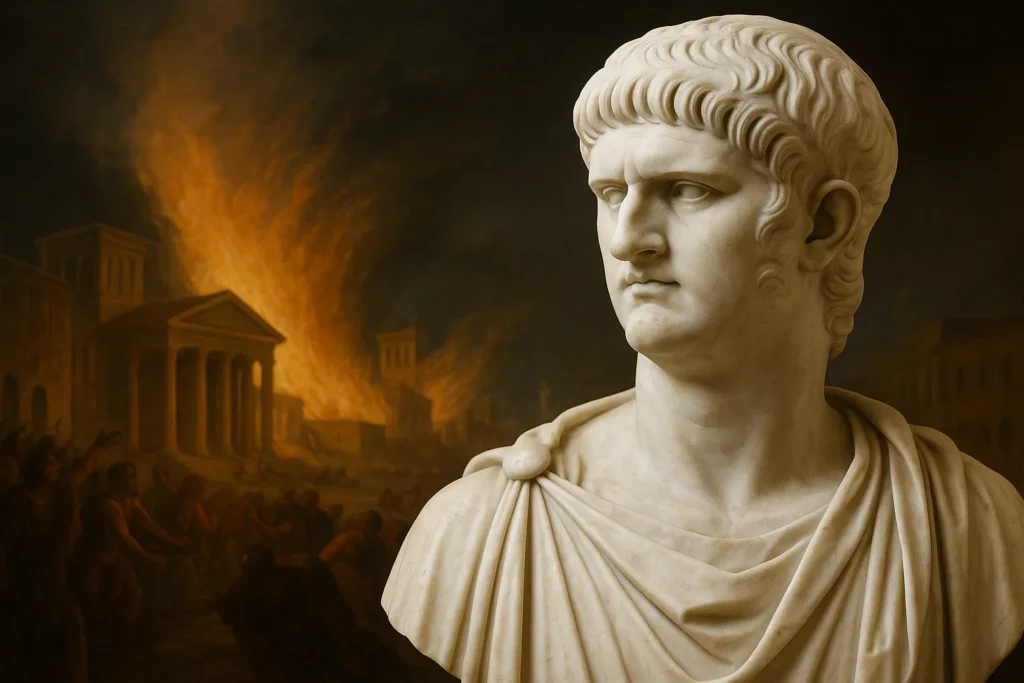When people search for the phrase Rome burner, they are often curious about one of history’s most dramatic events — the Great Fire of Rome in 64 AD. For centuries, the name has been tied to the infamous emperor Nero, who is often remembered as the ruler who let his city go up in flames. Some stories even claim he played music while Rome burned, turning tragedy into legend.
But was Nero truly the Rome burner, or is this one of history’s biggest myths? In this article, we’ll look at what really happened, how ancient writers shaped the story, and why the image of a burning Rome still captures the imagination today. You’ll discover where the myths came from, what modern experts say, and what lessons we can take from this event almost two thousand years later.
What Does Rome Burner Mean?
The term Rome burner is most often linked to the Great Fire of Rome, a huge blaze that destroyed much of the city in 64 AD. Because Emperor Nero’s name became tied to the disaster, many people use Rome burner as a way of describing him, even though historians still debate his role in the tragedy.
Over time, the phrase grew beyond its literal history. When someone says Rome is burning, it usually means that a crisis is unfolding while leaders seem careless or distracted. It’s a powerful image of neglect in the face of disaster.
You may also come across related phrases such as burn Rome, Rome is burning, or the well-known story that Nero fiddled while Rome burned. Together, these expressions show how deeply the fire — and Nero’s reputation — have influenced culture, language, and the way we talk about leadership during times of crisis.
Rome Before the Fire
To understand why the Great Fire spread so quickly, it helps to picture how Rome looked before the disaster. The city was a maze of narrow streets and crowded neighborhoods. Many people lived in tall apartment blocks called insulae, which were often built from wood and other flammable materials. A single spark in the wrong place could easily set off a chain of destruction.
This wasn’t the first time fire threatened Rome. Earlier blazes had already shown how vulnerable the city was, but rebuilding often followed the same risky patterns. Safety took a back seat to speed and demand, leaving the city exposed again and again.
Rome did have some protection in place. The Vigiles, a group that acted as both firefighters and night watchmen, patrolled the streets. They carried buckets, pumps, and axes, ready to battle flames when they broke out. But given the size of the city and the limitations of ancient tools, the Vigiles were often no match for massive fires that spread with the help of wind and tightly packed buildings.
The Great Fire of Rome (64 AD)
So when did Rome burn? The fire broke out in July of 64 AD, in the shops near the Circus Maximus. These stalls were packed with flammable goods, and once the flames started, they spread quickly through the crowded streets and wooden homes.
The fire raged for nearly a week, with flare-ups continuing even after it seemed under control. By the time it ended, ten of Rome’s fourteen districts had been damaged, and at least three were completely destroyed. The scale of the disaster was unlike anything the city had seen before.
We know about the event mainly through ancient writers. Tacitus gave a cautious account, noting the destruction but avoiding strong claims about who was responsible. Suetonius and Cassius Dio, on the other hand, were more critical of Nero and suggested darker motives. Together, their writings shaped much of what people believe today about the fire.
For ordinary Romans, the toll was devastating. Thousands lost their homes, families were torn apart, and whole communities disappeared in the flames. The panic, confusion, and displacement left a lasting mark on the city and its people.
Did Nero Burn Rome? Myth vs Reality
The most popular claim tied to the Great Fire is that Nero himself was the Rome burner. For centuries, people have pictured the emperor as the villain who either ordered the fire or simply watched as his city went up in flames.
One of the most famous stories says that Nero fiddled while Rome burned. The truth is, fiddles didn’t even exist at the time. If Nero played anything, it would have been the lyre, a stringed instrument common in Roman culture. Still, the image of a ruler entertaining himself while his people suffered was powerful enough to last through the ages.
Ancient historians gave mixed accounts. Tacitus, often considered the most reliable, reported the destruction but avoided saying outright that Nero caused it. Suetonius, who tended to focus on scandal, painted a harsher picture of Nero’s character. Cassius Dio went further, writing as if Nero had direct involvement in the disaster.
So why would Nero burn Rome? Some suggest he wanted space to build his grand palace, the Domus Aurea. Others think it was a way to remake the city according to his vision. But many modern historians believe these stories were shaped by political propaganda after Nero’s death. Blaming him made sense for later writers who wanted to portray him as the ultimate corrupt ruler.
Most experts today agree that while Nero’s reputation as the Rome burner is dramatic, it is more legend than fact. The fire was likely accidental, fueled by a city already at risk, and later turned into a tale that cemented Nero’s dark legacy.
Why Did Rome Burn So Quickly?
The speed and scale of the Great Fire weren’t just bad luck — the city itself made the disaster almost unavoidable. Many homes and apartment blocks were built from wood, packed tightly together, and often stocked with flammable goods. Once the first sparks caught, the flames found plenty to feed on.
The city’s dense neighborhoods acted like kindling. Narrow streets funneled the fire from one block to the next, while strong summer winds carried sparks across rooftops. Even areas that seemed safe could suddenly ignite, trapping families with little chance to escape.
Rome did have a firefighting force, but the tools of the time were limited. Buckets of water, simple pumps, and axes were useful for small blazes, but no match for a fire of this size. The flames often jumped ahead of the Vigiles before they could catch up.
To make matters worse, the fire reignited several times. After the first major wave, smaller outbreaks flared up in other parts of the city, undoing efforts to control the disaster. These repeated surges stretched resources thin and added to the sense of chaos and helplessness.
Nero’s Actions During and After the Fire
While Nero is often remembered as the Rome burner, ancient accounts also describe how he tried to help his people during the disaster. He opened his own gardens and other public spaces to give refugees a place to stay when their homes were gone. Food supplies were brought in, and temporary shelters were set up to provide relief for those left with nothing.
But his efforts were overshadowed by controversy. After the flames died down, Nero began building his extravagant palace, the Domus Aurea, right in the heart of the ruined city. For many, the timing looked suspicious — as if the fire had cleared the land just for his personal dream project. This fueled rumors that he had started the blaze himself.
On the practical side, Nero also introduced new building rules. Streets were made wider to stop fires from jumping so easily between buildings, and brick and stone were encouraged instead of wood. These measures made the city safer, but they couldn’t erase the suspicion that already surrounded him.
Scapegoating and the Christians
As anger over the fire grew, Nero needed someone to blame. He turned the public’s attention toward a small, unpopular group at the time — the early Christians. They were already viewed with suspicion by many Romans because their beliefs and practices were different from traditional religion.
Nero accused them of setting the fire, and the punishment was brutal. Many were arrested, tortured, and executed in cruel ways, including being burned alive or thrown to wild animals in public arenas. These punishments were meant not only to scare others but also to shift responsibility away from Nero.
This persecution left a deep mark on the Christian community. The suffering of those early believers became part of their identity and was remembered for centuries. In time, it even shaped how Christianity spread, with the victims seen as martyrs who had remained faithful despite terrible pain.
Life in a City After the Flames
For the people of Rome, the hardest part began once the fire was over. Thousands were left homeless, forced to sleep in makeshift shelters or out in the open. Food was scarce, and many families struggled to survive in a city where entire neighborhoods had vanished overnight.
The trauma of losing homes, loved ones, and community roots created a sense of despair that hung over the city. Anger and frustration quickly followed. Many Romans began to lose trust in their leaders, especially Nero, whose actions and grand rebuilding projects seemed to benefit himself more than the people.
Reconstruction also came at a heavy cost. To fund the rebuilding, new taxes were introduced and resources were stretched thin. While some areas of Rome were eventually rebuilt with stronger materials and wider streets, ordinary citizens often carried the financial burden. The fire not only scarred the city’s landscape but also left deep wounds in its social and economic life.
Legacy of the “Rome Burner” Story
The image of Nero as the Rome burner has lasted far longer than the fire itself. Even though historians debate his guilt, the story shaped his reputation for centuries. He became the symbol of a careless, selfish ruler — remembered more for scandal than for any of his reforms.
The phrase Rome is burning also took on a life of its own. Today, it’s used to describe moments of crisis when leaders ignore urgent problems or focus on personal gain instead of helping their people. It’s a reminder of how history can turn into a lasting metaphor.
Art, literature, and popular culture have kept the story alive. From paintings of Nero watching the flames to novels and films that dramatize the event, the burning of Rome is retold again and again as both tragedy and cautionary tale.
There are also lessons hidden in the ashes. The fire showed how dangerous poor city planning could be and how quickly disaster can strike when safety is ignored. Modern urban planning, fire codes, and disaster response strategies all carry echoes of Rome’s tragedy, proving that even ancient history still has wisdom to offer today.
Comparisons with Other Ancient Fires
The Great Fire of Rome wasn’t the only disaster of its kind. Centuries later, Constantinople suffered repeated fires that wiped out large parts of the city, showing how vulnerable ancient capitals were to flames. In 1666, London faced its own catastrophic fire, which destroyed most of the city and left thousands homeless, much like Rome had experienced.
In both cases, just like in Rome, leaders were blamed. When cities burned, people often looked for someone in power to hold responsible — whether or not the charges were fair. Disasters had a way of turning into political weapons, shaping the reputation of rulers for generations. Nero may be the most famous “fire villain” in history, but he wasn’t the only leader whose legacy was scorched by flames.
Frequently Asked Questions (FAQs)
What caused Rome to burn?
The fire began in July 64 AD near the Circus Maximus, likely from shops filled with flammable goods. Once it started, the wooden homes, narrow streets, and summer winds allowed the flames to spread rapidly. Most historians believe it was accidental rather than planned.
Who fiddled while Rome burned?
The famous story says Emperor Nero played the fiddle during the fire, but fiddles didn’t exist at that time. If he played anything, it would have been the lyre. The idea of “fiddling while Rome burned” became a metaphor for neglect rather than a proven fact.
What does it mean to say Rome is burning?
This phrase is often used as a metaphor for a crisis being ignored by leaders. It means something important is collapsing while those in charge are distracted or careless.
Is the Eternal Flame still burning in Rome?
Yes. In ancient Rome, the Vestal Virgins kept an eternal flame burning in the Temple of Vesta as a symbol of the city’s safety. Today, there is still a symbolic flame kept alive in the Roman Forum for visitors to see.
What did Nero do to Christians?
After the fire, Nero blamed Christians for the disaster. Many were arrested, tortured, and killed in cruel public executions, making them some of the earliest Christian martyrs in history.
Why did Romans burn their dead?
Cremation was a common Roman practice, especially in the early empire. Burning the body was seen as a way to purify the dead and return their spirit to the gods. It was also a practical solution in a crowded city where burial space was limited.
Conclusion
The story of the Rome burner is a mix of history and myth. The Great Fire of 64 AD was real, and its destruction changed the city forever. But whether Nero started the blaze or not remains uncertain. What is certain is that his name will always be tied to the flames, shaping how people remember him more than any of his other actions as emperor.
The legend of Nero fiddling while Rome burned may not be fact, yet it continues to live on as a warning about neglect and poor leadership during times of crisis. It reminds us that myths, even when untrue, have the power to shape reputations and influence how history is told.
In the end, understanding the truth matters more than clinging to legends. Looking back at the fire shows us not only the fragility of great cities but also how stories passed down through generations can outlast the events themselves. Rome burned, but its lessons — and its myths — still burn bright today.

Hi, I’m Bilal, the founder of outofmagazine.com. I love sharing fresh ideas, stories, and helpful insights on all kinds of topics that spark curiosity. My goal with this site is simple—to create a space where readers can find inspiration, useful tips, and engaging reads on lifestyle, trends, and everything in between.



